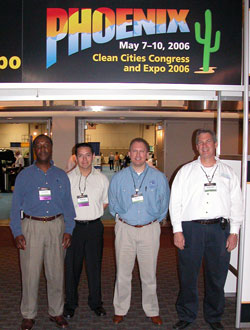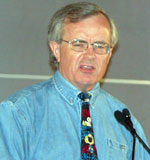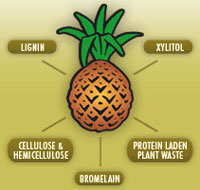 Our final day general session is going on right now.
Our final day general session is going on right now.
It’s being moderated by Andrew Littlefair, Clean Energy. Andrew has a challenge considering the panel has some very outspoken industry representatives but he’s handling it very well.
The panel consists of (l-r) Phil Lampert, NEVC, Scott Gerke, American Honda, Rich Kolodziej, NGVA, Joe Jobe, NBB and Brian Feehan, PERC.

I’m recording the complete session and will post a portion of it when complete. Then I think I’ll post pieces of it later as time permits.
While the session is going on the exhibit hall is still open. I’ve got some pics from it to post for you too.
Domestic Fuel coverage of the Clean Cities Congress is made possible by the following sponsors:




 The Clean Cities Congress crowd kind of changed the slogan for Alice Cooper’s Town a little last night to “Where Rock and Alternative Fuels Meet.”
The Clean Cities Congress crowd kind of changed the slogan for Alice Cooper’s Town a little last night to “Where Rock and Alternative Fuels Meet.”
 The band at our closing reception was Still Cruisin led by founder and drummer Bill Ball.
The band at our closing reception was Still Cruisin led by founder and drummer Bill Ball.
 The closing reception was held last night at
The closing reception was held last night at  On my way out of the convention center yesterday I stopped by the Ride & Drive and found myself in a
On my way out of the convention center yesterday I stopped by the Ride & Drive and found myself in a  At the end of the day today participants here at the Clean Cities Congress could ride and drive a variety of alt fuel vehicles.
At the end of the day today participants here at the Clean Cities Congress could ride and drive a variety of alt fuel vehicles. Our sponsor for coverage of the Clean Cities Congress is
Our sponsor for coverage of the Clean Cities Congress is  Annabel Cook, Honda, pictured here with Ed Huestis,
Annabel Cook, Honda, pictured here with Ed Huestis,  Giving us a light-hearted look at alternative fuels as only he can, Jim Kenzie, Chief Auto Reviewer for the
Giving us a light-hearted look at alternative fuels as only he can, Jim Kenzie, Chief Auto Reviewer for the 
 A Florida-based company is working to make ethanol from pineapples. Biomass Resources Corporation of Boca Raton reportedly has “achieved initial success at extracting Ethanol from pineapple fruit and pineapple plant waste,” according to a
A Florida-based company is working to make ethanol from pineapples. Biomass Resources Corporation of Boca Raton reportedly has “achieved initial success at extracting Ethanol from pineapple fruit and pineapple plant waste,” according to a